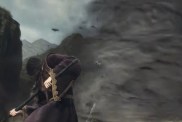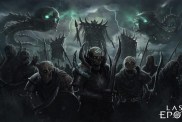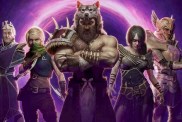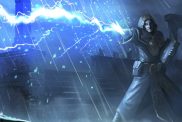Eye of Judgment General FAQ v0.2
By Jerry Hsu (confucious@gamefaqs, PSN - confu2000)
The latest version of this document will always be at
http://docs.google.com/Doc?id=dhgfk5zc_6c4gmz8.
I can be contacted at [email protected]
Table of contents
1. Introduction
2. Setting up
3. Gameplay
3.1. Basic Turn Order
3.2. The Board
3.3. Cards
3.4. Status effects
3.5. On-screen Information
4. Strategy
5. Tips
6. Troubleshooting
0. History
v0.2 - Made the card information section more
comprehensive. Restructured layout slightly.
v0.1 - Initial faq. Mostly random troubleshooting tips.
1. Introduction
The Eye of Judgment is a collectible card game for the PS3.
It uses the Playstation Eye to read cards and track in-game
stats for the player. A game will typically take 30 to 60
minutes though a drawn out game can take up to 90 to 120
minutes.
This FAQ is a WIP. Frankly, the manual for the game sucks
so I'm trying to supplement it for new players.
2. Setting up
The game manual does a reasonably decent job of explaining
how to setup the camera and play area.
A few tips which are also repeated in the troubleshooting
section:
* You don't need a particularly bright source of light and
in fact, too much light may tend to cause glare which can
also interfere with reading the cards.
* For camera settings, using a manual setting instead of
the automatic setting will usually produce better results.
* Make sure that your Playstation Eye stand is fully
compressed. If the alignment view shows any significant
space between the mat's grid and the green overlay grid,
then your stand is too tall and can be squeezed down
further.
* Lightly ironing your mat to remove the folds greatly
improves the play experience. It may also help detection
to a small degree.
* During online play, the game will draw cards for you (to
prevent cheating). So having your cards organized into
multiple piles will help make finding them faster.
3. Gameplay
3.1 Basic Turn Order
Start Phase
Both players start with 5 cards. Each player may review his cards and
choose to mulligan once (reshuffle and redraw) if they don't like their
hand. After both players have drawn their initial hands, the first
player begins his turn.
Draw Phase
A turn begins by drawing a card from the deck and receiving 2 mana.
The first player does not draw a card on his first turn (to balance
the advantage of going first).
If a player can not draw a card during this phase (or at any other
point) due to the deck being empty, he loses.
Attack Phase
During a turn, a player may, in any order, try to:
1) play spells,
2) activate an existing creature to have it attack,
3) rotate an existing creature,
4) summon a new creature.
Existing creatures may be turned 90 degrees once per turn and activated
once per turn.
Some spells may also end the turn as part of their effect so read the
descriptions carefully.
Options 1 to 3 may be performed multiple times per turn (2 and 3 on
different creatures) as long as the player has mana available to pay
for the associated costs.
Summoning a new creature will end the turn so the other actions must be
performed first.
If a player has no creatures on the board, he may summon a creature to
any field. Otherwise, creatures may only be summoned to fields
adjacent to any existing creature (allied or enemy). Fields that are
valid for summoning have a white highlight effect.
Newly summoned creatures will automatically attack. Creatures will not
attack if there are no enemy creatures in range (ie, they will not
attack allied creatures if those are the only ones in range).
Creatures will attack allied creatures if they have a forced multiple
square attack pattern (Twin Goblins for example) and there is an enemy
creature in range of one of their attacks.
Likewise, creatures can not be activated if there are no enemy
creatures in range.
If a creature is attacked from a direction that it can attack, then it
will normally counterattack. The attacking character first does damage
and then if the defending character is still alive, it will perform its
counterattack (ie. damage is not simultaneous). The counterattack is a
normal attack and so creatures that have multiple square attack
patterns will attack creatures on all squares (including allied
creatures).
Resolution Phase
At the end of the turn (either due to summoning or ending
the turn with the "End Turn" card), there are a few things
to check.
There is a hand limit of 7 that is checked at the end of your turn. If
you have more than 7 cards in your hand at the end of your turn, the
computer will direct you to discard down to 7.
If you now control 5 fields (due to summoning your 5th
creature), then you win.
An important thing to note here is that you must control 5
fields at the end of your turn. If you summon a 5th
creature, but it dies or causes another of your creatures
to die prior to the end of your turn, then the game
continues.
3.2. The Board
The board is a 3x3 grid. Boards in general seem to always begin with 2
fields each of Fire, Water, Earth and Wood elements and 1 Biolith.
Each field has two sides, the second side indicated by a small cutout
in the lower right corner. The element of the second side is not
necessarily the opposite element of the top side.
Flipping a field is called a "fieldquake" and can be performed by
spells and some creatures. More information on elemental effects are
in the next section.
3.3. Cards
Card Basics
There are 2 types of card, creature summons and spells.
All cards have a summoning/casting cost which is listed as the first
number on the left side.
Creature cards also have activation/rotation cost, initial HP and base
attack values.
Some cards have a lock and chain symbol around their summoning cost.
Almost all biolith cards seem to have this. The summoning lock is in
effect while there are fewer than 4 creatures on the board (in total
for both players). After the fourth creature is summoned, the
summoning lock will release and creatures that are locked can now be
played. If the number of creatures drops back below 4 (due to being
killed), the lock will go back into effect, but any creatures already
summoned are not affected.
A creature can have one of 6 elements: Wood, Earth, Fire, Water,
Biolith and Neutral.
Wood and Earth are in opposition, Fire and Water are in opposition.
Biolith and Neutral are both neutral.
For Wood, Earth, Fire and Water, creatures summoned on fields of their
own element gain a +2 hp bonus and fields of the opposing element
results in a -2 hp penalty. Biolith and Neutral creatures have no
penalty or bonus for any field.
In particular, this means that Biolith creatures do not get any benefit
from being summoned on Biolith fields.
Cards have two icons at the bottom, attack and defense.
Attack icons with only solid red arrows indicate that the creature can
and will attack multiple fields (Twin Goblins). Icons with solid red
and light red arrows indicate that the creature has the option of
attacking any one of the fields (Hellfire Spitter).
The primary purpose of the defense icon is to indicate blind spots for
the creature. An attack to the blind spot of a creature will do +1
damage. In general, if a creature is attacked from a position that
they can themselves attack, then they will counterattack. Some defense
icons may not make this obvious.
Special Creature Types
Fortress is a special type of creature. Despite what the attack icon
may seem to indicate, fortresses do not have an initial attack when
they are summoned. Fortresses will counterattack as appropriate.
Incarnations are another special creature. Incarnations can be
summoned on top of another creature of the same element. When they are
summoned this way, the cost is the difference between the incarnation
and the creature it is replacing. For example, if a Hellfire Spitter
is in play, the Scionder Fire God may be summoned on top of it for a
cost of 8 instead of the usual 9. When summoned this way, the
incarnation does not get an automatic attack and your turn does not
end. Creatures that are summoned this way can not be activated on the
same turn. You may still summon another creature afterwards (provided
you have enough mana).
3.4. Status effects
Cards may gain or have inherent status effects.
Quickness - Quickness allows the creature to counterattack first when
attacked. If the creature attacking also has quickness than that
creature will attack first as normal. If a quickness counterattack
kills the attacker, then the defending creature will take no damage.
Protection - Protection will absorb a certain amount of physical
damage. Protection from multiple sources stacks (ie, +2 protection
from one source and +1 from another results in +3 protection total).
If a creature has 2 hp and +2 protection, then a 3 damage attack will
only do 1 hp of damage. A 2 damage attack will do 0 damage.
Protection does not defend from magic attacks.
Dodge - Dodge provides a 50% chance that a physical attack will miss.
Dodge can be provided from multiple sources. So a creature will 2
dodge attempts has effectively a 25% chance that a physical attack will
miss. Magic attacks bypass dodge.
Perfect Dodge - Perfect dodge provides a 100% chance that a physical
attack will miss (effectively immunity from physical attacks). Magic
attacks bypass perfect dodge.
Invisibility - Invisibility provides immunity from both magic and
physical attacks. Your only hope for a creature with invisibility is
to either remove the source of invisibility or to try to
move/fieldquake the creature to an opposing element field and hope
that the resulting hp loss will kill it.
Possession - A possessed card is still owned by its
original owner but can no longer be controlled. The
possessor may trigger the card's attack on the turn after
it is possessed.
3.5 On-screen Information
The sides of the screen list your mana, number of cards in
your deck, number of cards in your hand and number of cards
in your discard.
The first row for creature overlays shows the current HP
and attack power.
The second row shows the costs for the creature: summoning,
activation, rotation. Note that though activation and
rotation start the same, they can be affected by various
status effects independently.
The third row shows icons indicating from left to right:
quickness, protection, dodge/perfect dodge, change to a
cost.
4. Strategy
<empty for now>
5. Tips
* It can be hard to see the elements of the board at times. R1 will
toggle through a few displays, one of which shows the front/back
elements of the board. The normal hp/attack display also shows the
elements of the field the creature is summoned on by colors in the
upper left (top field) and lower right (flip field) corners.
* During online play, you'll want to use the status screen frequently
to see what the opponent's cards can do/attack patterns/blind spots
(since you won't have them physically in front of you). L1 will bring
up the status screen and I find it easier than using the status card.
* During online play, the computer draws your cards for you
to prevent deck stacking. Press X to review your current
hand if you lose track.
* Creatures do not have a "max" hp, just a starting hp. Healing
effects will always work and have no inherent limit.
6. Troubleshooting
Q: The Eye doesn't recognize my cards on the field.
A: The game is capable of working with fairly low amounts
of light. Among things I've heard, I'd say the first thing
to do would be to go to camera setup and change the camera
setting off of Automatic exposure and set it to
Warm/Normal/Blue as appropriate for your lighting type
(incandescent, fluorescent) and Dark/Normal/Bright for the
amount of lighting. Many people find that Warm/Dark works
well.
Another thing is to make sure the stand for your Eye is
properly assembled. The tubes for the stand are very tight
and it is easy to have the stand be too tall after you
initially assemble it. During the alignment screen where
the Eye shows the field with a green overlay grid, the grid
should match up with the field very tightly. If the grid
is larger than the field by any amount, your stand is
probably too tall and you should apply some more force to
squeezing it down. Another way to tell if your stand is
too tal is if it seems wobbly. The stand when properly
assembled should be pretty stable.
Q: The Eye can see the field fine, but I can't get it to
recognize my discards (for spells or other effects).
A: The first thing is to make sure you're holding the card
properly. The Eye sees the cards by using the green
triangles and the black bars at the top and bottom. If any
of those are obscured, it won't recognize the card
properly. So either holding the card in the palm of your
hand flat, or along the middle, sideways with your fingers
between the green triangles should work well. I find the
second lets me hold the card steadier.
The second thing is that the Eye wants the cards held up
towards it. This means that you should hold the card in
the air about midway between the board and the Eye. I've
found the Eye can get confused if the discard card is too
close too the board.
Q: The game lets me setup a room and I can even voice chat
with my opponent, but when it starts the game, I'm stuck at
waiting and then the opponent disconnects.
A: I believe this problem is due to your router. I think
the game uses VPN for transferring the game data (cards
played). Some routers do not handle VPN data well. I've
had problems with the Apple Extreme Base Station. For this
particular router, I need to specify the PS3 as the
"default host". This might be known as DMZ on some other
routers. If you have problems, I suggest googling your
router model with "VPN" or "VPN problems" to see if there
are any solutions.
Q: The game tells me that a card is invalid to place but
I'm sure it is.
A: Especially in online, the game has certain states that
it enforces to prevent things like accidental re-summoning
of creatures. If you place a card and the game reports
that it is invalid, remove the card and wait a few seconds
for the game to recognize that the state is correct. Then
replay the card. It should be accepted at this time.
Playing a card too quickly will most likely result in
"invalid" messages.
It's also possible that there is a limitation that you're
not aware of. In offline, the game will enforce card
restrictions such as having only 3 of any single card in
your deck. Online, the game will prevent you from playing
a spell card if your hand does not contain the appropriate
discards needed to fuel the card. And remember to be aware
of things like summoning locks.

Embark on an inspiring mission of human connection beyond the UCA. Sam — with companions by his side — sets out on a new journey to save humanity from extinction. Join them as they traverse a world beset by otherworldly enemies, obstacles and a haunting question: should we have connected?










